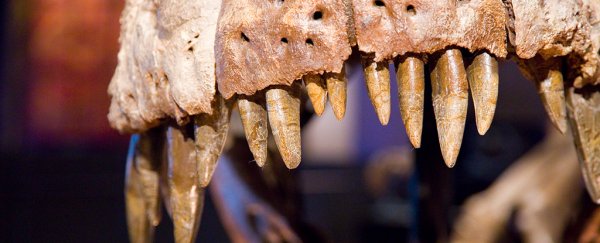A towering colossus and predatory beast, the comically tiny-armed Tyrannosaurus rex is perhaps the most iconic of all prehistoric predators. Its place in the popular imagination is mirrored in academia, with researchers investigating everything from how it walked, to how it mated, to how many there even were.
Despite abundant research into the genus Tyrannosaurus, all adult specimens from the plains of Canada to the southwestern United States belong to a single species: T. rex. However, paleontologists have now rigorously analyzed their skeletal variation, and the results suggest the infamous dinosaur may in fact be… three different species.
For some time, scientists have recognized differences in the skeletal morphology of Tyrannosaurus specimens, most notably the femur (thigh bone) in similarly sized individuals, and specimens with either one or two slender incisor teeth at the front sides of the jaw.
These differences, however, have been mostly put down to sexual dimorphism – when male and female members of the same species appear different. Other explanations for these differences include individuals being at different stages of genetic development, or simply individual variation.
A last possible explanation is the most intriguing, though – that these differences represent distinct species within the genus Tyrannosaurus.
Paleontologists took anatomical measurements from the bones and dental remains of 38 Tyrannosaurus specimens. They compared femur bones in 24 of the specimens, giving an indication of robustness and strength. They also measured the diameter of the base of teeth or space in the gums to see if the individuals had one or two incisor teeth.
The degree of 'robustness' (which describes the strength of the bone based on circumference and length) appeared to have no relationship with the absolute size of the specimens, suggesting the femur variations couldn't simply be explained by older, bigger individuals having stronger bones. In fact, some of the largest specimens had comparatively 'gracile' bones, which are more slender and curved.
Overall, robust femurs outnumbered gracile femurs 2:1 among the specimens, suggesting the differences were not down to sexual dimorphism, where you would expect a more even distribution.
Twenty-nine of the Tyrannosaurus specimens in the study had been found in distinct geological layers of sediment at the Lancian upper Maastrichtian formations in North America (thought to be from roughly 67.5 to 66 million years ago).
These sediments can be divided into three levels: lower, middle, and upper. Interestingly, of the six femurs found in the lower layer, all were robust. Towards the middle, only one gracile femur was found, and in the top layer there was a more even split of both types. This variation in the top layer was also significantly higher than what we've seen in other theropod species found in these sediments.
These findings strongly suggest that, as time went on, Tyrannosaurus diverged into physiologically distinct specimens.
"We found that the changes in Tyrannosaurus femurs are likely not related to the sex or age of the specimen. We propose that the changes in the femur may have evolved over time from a common ancestor who displayed more robust femurs to become more gracile in later species," says paleontologist Gregory Paul, lead author of the paper.
"The differences in femur robustness across layers of sediment may be considered distinct enough that the specimens could potentially be considered separate species."
As a result of their findings, the researchers have now described three 'morphotypes' recognizable with the genus Tyrannosaurus.
Based on these, the team has nominated two new potential species, with the first being T. imperator (tyrant lizard emperor) – specimens found at the lower and middle layers of sediment who have more robust femurs and usually two incisor teeth.
The second, T. regina (tyrant lizard queen), is linked to the upper and possibly middle layers of sediment; it had smaller, more gracile femurs and one incisor tooth.
The already known T. rex (tyrant lizard king) was identified in the upper and middle layer of sediment, with individuals carrying more robust femurs while only having one incisor tooth.
The authors do caution that these differences are not definitive of distinct new species, and cannot entirely rule out the possibility of atypical sexual dimorphism, or the other previously mentioned explanations due to the small number of specimens analyzed, along with uncertainty surrounding the location of some of the specimens within the sediment layers.
However, the team thinks the relationship between the specimens' physical variation and their location in the geologic record does indeed point to the existence of two previously unknown species of Tyrannosaurus.
In the future, the researchers expect the revision of these new species to be included, if more specimens are found that fit their newly devised framework.
The study was published in Evolutionary Biology.
